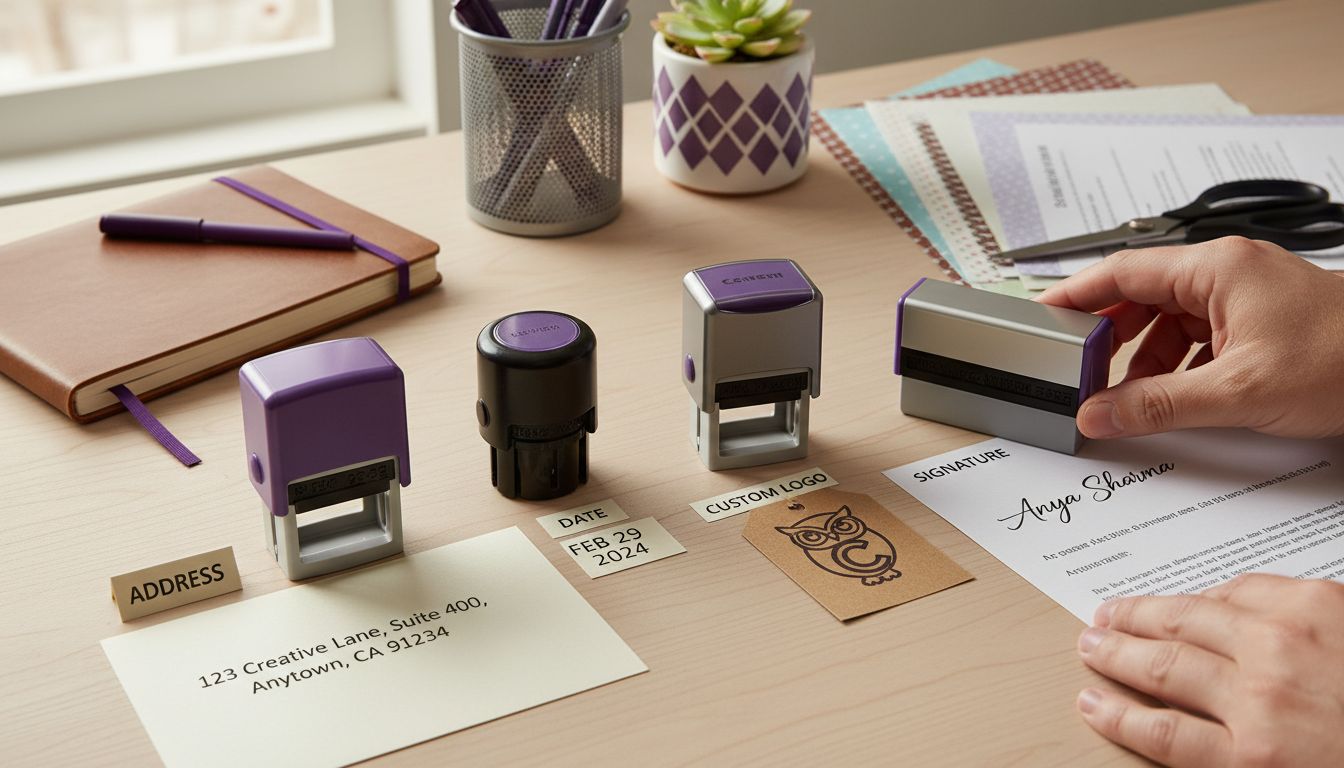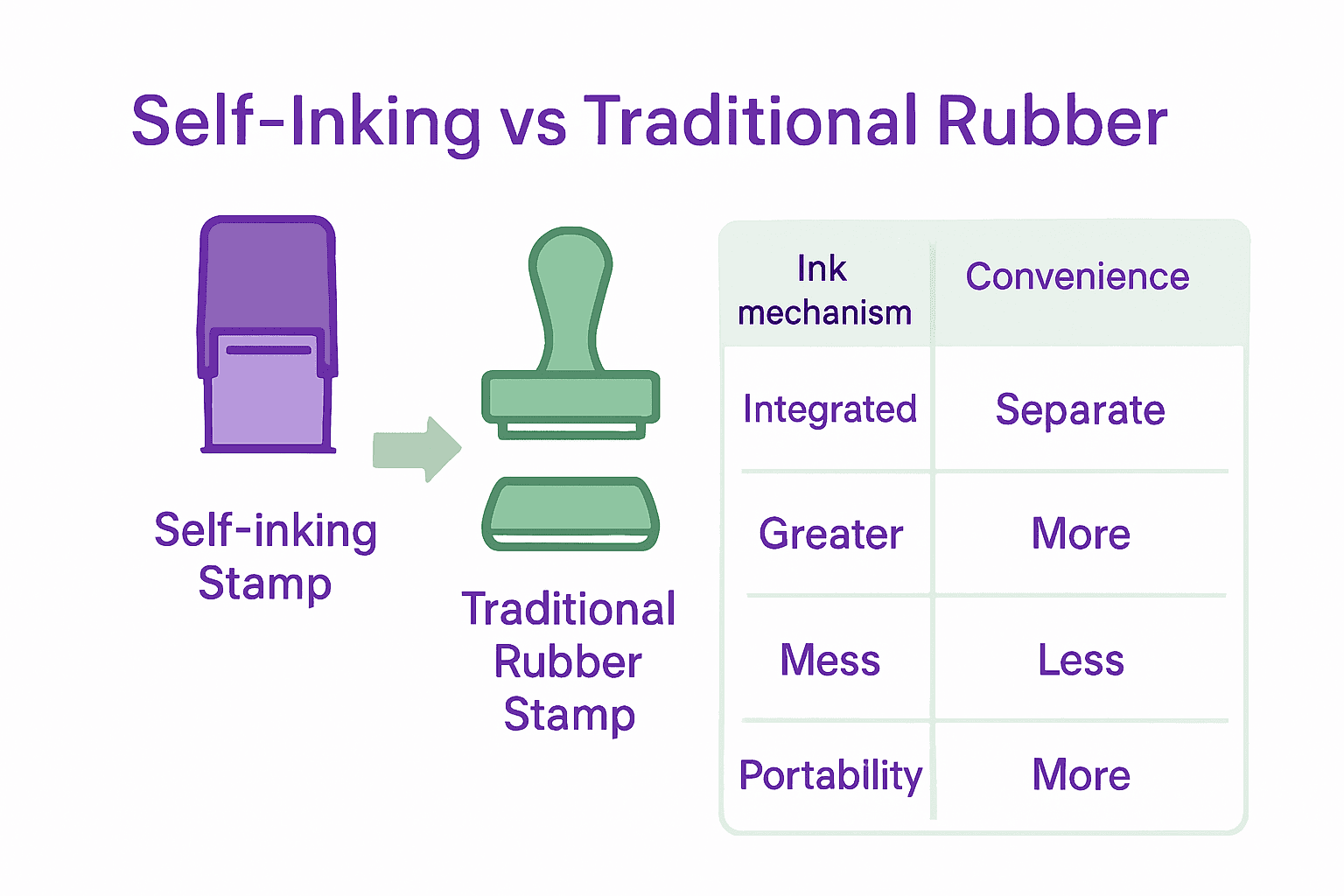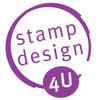Every year, offices and businesses worldwide use billions of stamps for paperwork and administration. Self-inking stamps have become the go-to choice for quick, mess-free marking, saving both time and effort. Whether you need to mark invoices or personalise letters, these modern stamps bring efficiency to daily tasks. Understanding the unique features and advantages of self-inking stamps helps you choose the best tool for smooth, reliable results.
Table of Contents
- Self-Inking Stamp: Definition And Key Concepts
- Types Of Self-Inking Stamps Explained
- How Self-Inking Stamps Work Mechanically
- Practical Uses For Self-Inking Stamps
- Comparing Self-Inking With Alternative Stamps
- Costs, Maintenance, And Common Mistakes
Key Takeaways
| Point | Details |
|---|---|
| Self-Inking Stamps Functionality | They automatically re-ink after each use, offering efficiency and consistent impressions without the mess of traditional stamps. |
| Versatile Applications | Suitable for both professional and personal tasks, including document marking, authentication, and creative projects. |
| Mechanical Design Advantages | The integrated ink mechanism and spring-loaded system ensure minimal user effort and high-quality result. |
| Cost and Maintenance Awareness | Initial costs range from £10 to £50, with ongoing maintenance for ink replacements; proper care is essential for longevity. |
Self-Inking Stamp: Definition and Key Concepts
A self-inking stamp is a specialised printing device that automatically re-inks its stamp pad after each impression, enabling quick and consistent document marking without separate ink pads. According to the Institute of Making, modern stamp technologies have evolved to include advanced features like fluorescent and phosphorescent inks for enhanced functionality.
Unlike traditional rubber stamps that require manual re-inking, self-inking stamps integrate an internal ink pad mechanism. When pressed, the rubber stamp surface rotates to contact the built-in ink pad, re-applying ink automatically before making an impression. This design offers several key advantages:
- Consistent ink coverage
- Quick and efficient stamping
- Reduced manual handling
- Compact and portable design
- Minimal mess compared to traditional stamping methods
The UK Intellectual Property Office recognises these stamps as essential office requisites, particularly for official documentation and administrative processes. Businesses and individuals can use self-inking stamps for various purposes, including address marking, document authentication, and professional correspondence.
While self-inking stamps come in multiple sizes and ink colours, their core mechanism remains consistent. The internal spring-loaded mechanism ensures each stamp produces a clean, crisp impression with minimal user effort. Whether you need to mark invoices, sign documents, or create custom impressions, these versatile tools provide a practical and efficient solution for everyday stamping requirements.
Types of Self-Inking Stamps Explained
Self-inking stamps come in a diverse range of types, each designed to meet specific professional and personal needs. According to the UK Intellectual Property Office, various stationery items including stamps are used in official capacities, highlighting the importance of understanding different stamp variations.
Professional Self-Inking Stamps typically include several key categories:
- Address Stamps: Ideal for businesses and personal use, featuring pre-printed contact information
- Date Stamps: Used for document tracking and official record-keeping
- Custom Logo Stamps: Enabling businesses to mark documents with brand identifiers
- Signature Stamps: Providing quick authentication for repetitive documentation
Personalised stamp creation has become increasingly sophisticated, as demonstrated by resources like the University of the Arts London, which offers advanced materials for custom rubber stamp production. These innovations mean individuals and organisations can now create highly specialised stamps tailored to their exact requirements.
Beyond professional applications, self-inking stamps serve diverse purposes across various sectors. From legal documentation and administrative processes to creative projects and personal organisation, these versatile tools offer a quick and efficient method of marking documents. The ability to choose from different ink colours, sizes, and custom designs ensures that there’s a self-inking stamp solution for virtually every stamping need.

How Self-Inking Stamps Work Mechanically
Self-inking stamps represent a sophisticated mechanical design that revolutionises traditional stamping techniques. As demonstrated by the Institute of Making, modern stamp technologies have incorporated advanced materials and mechanisms to enhance functionality, including innovations like fluorescent and phosphorescent inks for improved performance.
The core mechanical process of a self-inking stamp involves several intricate components:
- Integrated Ink Pad: A built-in ink reservoir that automatically re-inks the stamp surface
- Spring-Loaded Mechanism: Enables smooth rotation and precise ink application
- Rubber Stamp Surface: Rotates to contact the ink pad between impressions
- Pressure Plate: Triggers the stamping and re-inking sequence
The University of the Arts London highlights the precision of modern stamp production, with laser engraving techniques allowing for incredibly detailed and accurate stamp designs. When the stamp is pressed, the internal mechanism performs a complex sequence: the rubber stamp surface rotates away from the ink pad, makes an impression on the paper, then automatically returns to re-ink itself for the next use.
This ingenious design eliminates the need for separate ink pads and minimises user intervention. The self-contained mechanism ensures consistent ink coverage, reducing mess and improving efficiency. Whether used in office settings, creative projects, or personal organisation, self-inking stamps represent a clever solution to the traditional challenges of manual stamping, combining mechanical innovation with practical functionality.
Practical Uses for Self-Inking Stamps
Self-inking stamps have become indispensable tools across various professional and personal domains. According to the UK Intellectual Property Office, these stamps play a crucial role in official documentation and correspondence, highlighting their widespread practical applications.
Professional Applications include:
- Document authentication and validation
- Inventory and stock management
- Marking confidential or processed documents
- Quick address and return information stamping
- Tracking receipt and processing dates
Creative professionals also find innovative uses for these versatile tools. The Royal Academy of Arts demonstrates the artistic potential of stamps, showcasing how they can be used beyond traditional administrative tasks. From crafting and scrapbooking to creating unique design elements, self-inking stamps offer remarkable versatility.
Beyond business and art, self-inking stamps serve numerous personal organisational needs. They’re perfect for home filing systems, marking children’s belongings, creating personalised stationery, and even managing household paperwork. The quick, mess-free nature of these stamps makes them an efficient solution for anyone seeking to streamline their document management and add a professional touch to their personal or work-related materials.
Comparing Self-Inking With Alternative Stamps
Stamp technologies have evolved significantly, with self-inking stamps representing a modern advancement over traditional stamping methods. According to the Institute of Making, innovative approaches now include stamps printed with advanced materials like fluorescent and phosphorescent inks, expanding the functionality beyond conventional designs.
Key Comparison Points:
-
Traditional Rubber Stamps
- Require separate ink pads
- More manual intervention
- Higher potential for messy ink application
- Lower initial cost
-
Self-Inking Stamps
- Integrated ink mechanism
- Minimal manual handling
- Consistent, clean impressions
- Higher initial investment
The University of the Arts London further demonstrates the technological progression, offering laser stamp rubber that enables highly customised stamp production. This innovation allows users to create precise, professional-grade stamps with unprecedented detail and personalisation.
Ultimately, the choice between stamp types depends on specific user requirements. Self-inking stamps excel in high-volume environments where efficiency and consistency are paramount, while traditional stamps might suit occasional or specialised use. The key is matching the stamping tool to your specific documentation, branding, or creative needs.

Here’s a comparison of self-inking stamps with traditional rubber stamps:
| Feature | Self-Inking Stamp | Traditional Rubber Stamp |
|---|---|---|
| Ink Mechanism | Integrated ink pad | Separate ink pad required |
| Convenience | Quick, one-step operation | Manual re-inking needed |
| Mess/Ink Control | Minimal mess | Higher potential for mess |
| Imprint Consistency | Consistent, crisp impressions | Variable, user-dependent |
| Maintenance | Ink pad replacement needed | Regular pad re-inking |
| Portability | Compact, self-contained | Bulkier with separate pad |
| Typical Cost | Higher initial investment | Lower upfront cost |
Costs, Maintenance, and Common Mistakes
Self-inking stamps represent an investment that requires careful consideration of ongoing costs and maintenance. The Royal Academy of Arts highlights the importance of understanding the financial and practical aspects of stamp ownership, demonstrating that these tools are more than just simple purchasing decisions.
Cost Breakdown:
- Initial Purchase: £10 - £50 depending on complexity
- Ink Replacement: £3 - £12 per ink pad
- Custom Design: Free of Charge
Common Maintenance Mistakes:
- Storing stamps in direct sunlight
- Failing to clean stamp surfaces regularly
- Using incorrect ink types
- Applying excessive pressure during stamping
- Ignoring early signs of wear
The University of the Arts London emphasises the significance of proper stamp creation and maintenance, particularly for custom designs. Professional-grade stamps require regular care to maintain their precision and performance.
To maximise your stamp’s lifespan, clean the rubber surface after each use, store in a cool dry place, and replace ink pads when impressions become faint. Avoid exposing stamps to extreme temperatures or harsh chemicals. By investing a few minutes in routine maintenance, you can ensure your self-inking stamp remains a reliable tool for years, delivering crisp, consistent impressions every time.
Discover the Perfect Self-Inking Stamp for Your Needs
Choosing the right self-inking stamp can feel overwhelming with so many options and mechanical details to consider. If you want a reliable, clear, and mess-free stamping solution for your business or personal use, understanding the mechanism and maintenance is just the start. You need a partner that specialises in customisation to create a stamp that fits your branding or practical requirements perfectly.

Explore bespoke solutions at Stamp Design 4U, where you can design your own rubber stamps to suit your exact needs. Whether you require a professional address stamp, a custom logo stamp, or an efficient date stamp that saves time, you will find an easy to use platform with expert support. Act now and benefit from quality craftsmanship and quick delivery to enhance your stamping tasks with confidence and style. Visit https://stampdesign4u.co.uk today and start creating your ideal self-inking stamp.
Frequently Asked Questions
What is a self-inking stamp?
A self-inking stamp is a printing device that automatically re-inks its stamp pad after each impression, allowing for quick and consistent marking of documents without the need for separate ink pads.
How do self-inking stamps work?
Self-inking stamps utilise an integrated ink pad and a spring-loaded mechanism. When pressed, the stamp surface rotates to contact the ink pad, which re-inks itself automatically before making an impression.
What are the advantages of using a self-inking stamp compared to traditional rubber stamps?
Self-inking stamps offer consistent ink coverage, quick operation, reduced manual handling, a compact design, and minimal mess compared to traditional rubber stamps, which require separate ink pads and more manual effort.
What are the common uses for self-inking stamps?
Self-inking stamps are used for document authentication, address marking, date stamping, inventory management, and creative projects like crafting and personal organisation, thanks to their versatility and efficiency.

